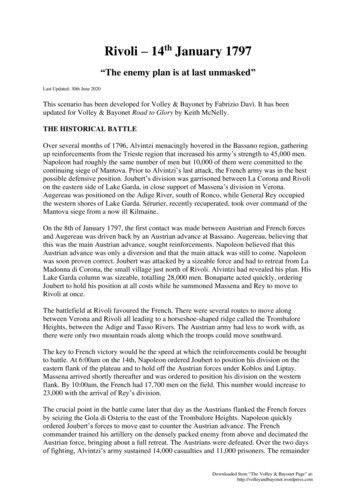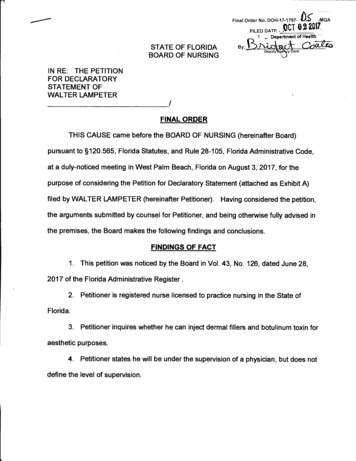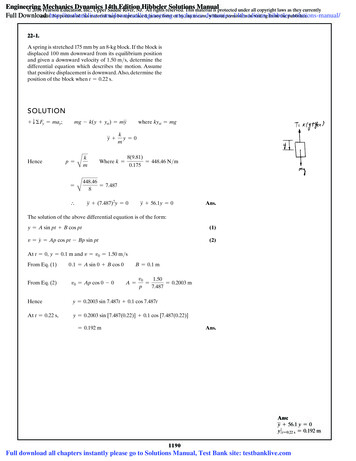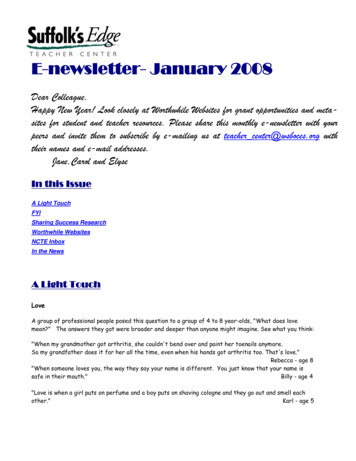
Transcription
Rivoli – 14th January 1797“The enemy plan is at last unmasked”Last Updated: 30th June 2020This scenario has been developed for Volley & Bayonet by Fabrizio Davì. It has beenupdated for Volley & Bayonet Road to Glory by Keith McNelly.THE HISTORICAL BATTLEOver several months of 1796, Alvintzi menacingly hovered in the Bassano region, gatheringup reinforcements from the Trieste region that increased his army’s strength to 45,000 men.Napoleon had roughly the same number of men but 10,000 of them were committed to thecontinuing siege of Mantova. Prior to Alvintzi’s last attack, the French army was in the bestpossible defensive position. Joubert’s division was garrisoned between La Corona and Rivolion the eastern side of Lake Garda, in close support of Massena’s division in Verona.Augereau was positioned on the Adige River, south of Ronco, while General Rey occupiedthe western shores of Lake Garda. Sérurier, recently recuperated, took over command of theMantova siege from a now ill Kilmaine.On the 8th of January 1797, the first contact was made between Austrian and French forcesand Augereau was driven back by an Austrian advance at Bassano. Augereau, believing thatthis was the main Austrian advance, sought reinforcements. Napoleon believed that thisAustrian advance was only a diversion and that the main attack was still to come. Napoleonwas soon proven correct. Joubert was attacked by a sizeable force and had to retreat from LaMadonna di Corona, the small village just north of Rivoli. Alvintzi had revealed his plan. HisLake Garda column was sizeable, totalling 28,000 men. Bonaparte acted quickly, orderingJoubert to hold his position at all costs while he summoned Massena and Rey to move toRivoli at once.The battlefield at Rivoli favoured the French. There were several routes to move alongbetween Verona and Rivoli all leading to a horseshoe-shaped ridge called the TrombaloreHeights, between the Adige and Tasso Rivers. The Austrian army had less to work with, asthere were only two mountain roads along which the troops could move southward.The key to French victory would be the speed at which the reinforcements could be broughtto battle. At 6:00am on the 14th, Napoleon ordered Joubert to position his division on theeastern flank of the plateau and to hold off the Austrian forces under Koblos and Liptay.Massena arrived shortly thereafter and was ordered to position his division on the westernflank. By 10:00am, the French had 17,700 men on the field. This number would increase to23,000 with the arrival of Rey’s division.The crucial point in the battle came later that day as the Austrians flanked the French forcesby seizing the Gola di Osteria to the east of the Trombalore Heights. Napoleon quicklyordered Joubert’s forces to move east to counter the Austrian advance. The Frenchcommander trained his artillery on the densely packed enemy from above and decimated theAustrian force, bringing about a full retreat. The Austrians were defeated. Over the two daysof fighting, Alvintzi’s army sustained 14,000 casualties and 11,000 prisoners. The remainderDownloaded from “The Volley & Bayonet Page” at:http://volleyandbayonet.wordpress.com
of the Austrian army retreated up the Adige signaling the end of the Austrian offensive of1796-7 in Northern Italy.All that remained was the siege of Mantova. Würmser held out until the 2nd of February1797, when the fortress was turned over peacefully to the French. Of the garrison of 30,000men, only 16,000 were able to walk out of the fortress without assistance. The fall ofMantova completed Napoleon’s conquest of Northern Italy. Napoleon may have won thebattles but the war was not over. The Austrian Government refused to capitulate to the FrenchGovernment and made preparations to create another army under their best commander, theArchduke Charles.Account taken from http://geog.queensu.ca/napoleonatlas/GAME LENGTH AND VICTORY:The battle starts at 8am and ends at the end of the 5 PM turn, for a total of ten turns.The French win by exhausting at least four Austrian columns. The Austrian win by collapsingat least two French divisions. All other results are considered to be a draw.DEPLOYMENTThe armies are deployed as follows.AUSTRIAN DEPLOYMENTThe 2nd, 3rd and 4th Austrian Columns (Ocksay, Koblos, Liptay) are deployed at “B”FRENCH DEPLOYMENTThe French divisions are deployed as follows: “J” - Division Joubert; “M” - DivisionMassena; “N” - Napoleon, 39th DB and Heavy Artillery.REINFORCEMENTSReinforcements arrive as follows.Turn 1 (8:00AM) 5th Austrian Column enters at point “C”TURN 2 (9:00 AM) 6th Austrian Column enters at point “D”TURN 4 (11:00 AM) 1st Austrian Column enters at point “A”Downloaded from “The Volley & Bayonet Page” at:http://volleyandbayonet.wordpress.com
TURN 5 (12:00 PM) Division Rey enters at point “R”BATTLEFIELDThe battlefield is 8’ x 6’. Rivoli is a stone town all other buildings are classed as stonevillages. The Adige is unfordable. The Torrente Tasso is a stream.SCENARIO NOTESThe Austrian 6th Column can launch a bridge of boats across Adige south of Ceradino byputting a unit of infantry adjacent to the river without French units within 6 inches. A bridgewill be available from the next turn.All Austrian infantry are rated as linear, except those as skirmish detachments. Frenchinfantry, other than skirmishing detachments, are rated on massed stands. All cavalry arelinear. The Austrian 2nd, 3rd and 4th column infantry are without dedicated guns due to poorroads.Downloaded from “The Volley & Bayonet Page” at:http://volleyandbayonet.wordpress.com
SOURCES:The following sources were used to develop this scenario.1797 Rivoli - Boardgame by M. Brandsma and F. Bey published on the French magazine VaeVictis 18.Napoleon’s campaign in Italy, 1796-1800. Part six: the battle of Rivoli, by A. M. Sayce.Wargames Illustrated 198, March 2004.D. Chandler, The battles of Napoleon (Italian ed. 1968).D. Chandler, Napoleon Marshals (Italian ed. 1988).S. Miller,The Austrian order-of-battle at Rivoli, 14-15 January 1797 on http://www.napoleonseries.org/military/battles/C rivoli.htmlThe battle of Rivoli, by the Napoleonic Miniature Wargame Society of Torontoon htmlDownloaded from “The Volley & Bayonet Page” at:http://volleyandbayonet.wordpress.com
AUSTRIAN ARMYAustrian Army of Italy, General Baron Joszef Alvintzy AC1st Column: Colonel Lusignan DC, Exhaustion 4 IR#14 (Klebek)IR#40 (Mitrowsky)IR#45 (Lattermann)Freikorp Gyulai 1st Batt.M4M4M4M5[ ][ ][ ][s][ ] [ ] NE/DG[ ] NE/DG[ ] NE/DG[s]M4M4M4M4M5[ ][ ][ ][ ][s][[[[]]]]NENENENEM5M5M5M5M4[ ][ ][ ][ ][s][[[[]]]]NENENENEM5M5M5M4[[[[[ ] NE[ ] [ ] NE[ ] ShockltM5M5M5M5M5M5M5M5M5M5[s][s][s][s][ ][ ][ ][ ][s][s]2nd Column: General Lipthay DC, Exhaustion 5 IR#53 (Jellacic)/lwIR#53 (Jellacic)/rwIR#8 (Huff)IR#37 (De Vins)Freikorp Gyulai 2nd Batt.3rd Column: General Köblös DC, Exhaustion 5 IR#24 (Preiss)IR#25 (Brechainville)IR#42 (Erbach)Combined batt.n (11, 27,29)Mahoney Jager4th Column: General Ocskay DC, Exhaustion 5 IR#4 (Deutschmeister)IR#45 (Lattermann)Composite GrenadiersComposite Cavalry]]]]5th Column: General Prince Reuss DC, Exhaustion 7 Composite Wallacher Grenz #1Composite Wallacher Grenz #1Carlstader Grenz 5th Batt.nCarlstader Grenz 7th Batt.nIR#4 (Deutschmeister)IR#26 (Schroeder)IR#36 (Furstenberg)IR#54 (Callenberg)HR#30 Wurmser HussarsErz. Joseph Anton Hussars6th Column: General Vukassovich DC, Composite Carlstader Grenz #1Composite Carlstader Grenz #1[ ][ ][ ][ ]ltlt[ ] NE/DGNENENEExhaustion 5M5 [s]M5 [s]Downloaded from “The Volley & Bayonet Page” at:http://volleyandbayonet.wordpress.com
IR#39IR#52FieldField(Nadasdy)(Erzherzog Anton-Viktor)Artillery 1Artillery 2M4M4M5M5[[[[]]]][[[[] NE/DG] NE/DG]]Downloaded from “The Volley & Bayonet Page” at:http://volleyandbayonet.wordpress.com
FRENCH ARMYFrench Armee d’Italie, Général Napoleon Bonaparte AC - Monarch 39th DB LigneHeavy Art.1Heavy Art.2M5 [ ] [ ] [ ]M5 [ ] [ ]M5 [ ] [ ]Général Joubert DC, Exhaustion 9 22nd Chasseurs a ChevalJoubert Field Art.Brigade Vial (4th DB Légère)Brigade Vial (17th DB Légère)Brigade Sandos (22nd DB Légère)Brigade Sandos (14th, 33rd DB Ligne)Brigade Lebley (29th DB Légère)Brigade Lebley (85th DB Ligne):M5M5M6M6M5M5M5M5[s][ ][ ][ ][ ][ ][ ][ ]Lt[ ][ ][ ][ ][ ][ ][ ][[[[]]]]M5M5M5M5M5M5[[[[[[]]]]]]Hvy[ ][ ][ ][ ][ ][[[[]]]]M5M5M5M5[[[[]]]][ ] [ ][ ] [ ][ ]MdGénéral Masséna DC, Exhaustion 7 1st CavalerieMasséna Field Art.Brigade Monnier (18th DB Ligne- lw)Brigade Monnier (18th DB Ligne- rw)Brigade Brune (75th DB Ligne)Brigade Rampon (32nd DB Ligne)Général Rey DC, Exhaustion 4 Brigade Baraguey d'Hilliers (58th DB Ligne-lw)Brigade Baraguey d'Hilliers (58th DB Ligne-rw)Brigade Murat (12th DB Légère)8th Dragoon Regt. /Guides and GendarmesDownloaded from “The Volley & Bayonet Page” at:http://volleyandbayonet.wordpress.com
“The enemy plan is at last unmasked” Last Updated: 30th June 2020 This scenario has been developed for Volley & Bayonet by Fabrizio Davì. It has been updated for Volley & Bayonet Road to Glory by Keith McNelly. THE HISTORICAL BATTLE Over several months of 1796, Alvintzi menacingly hovered in the Bassano region, gathering











